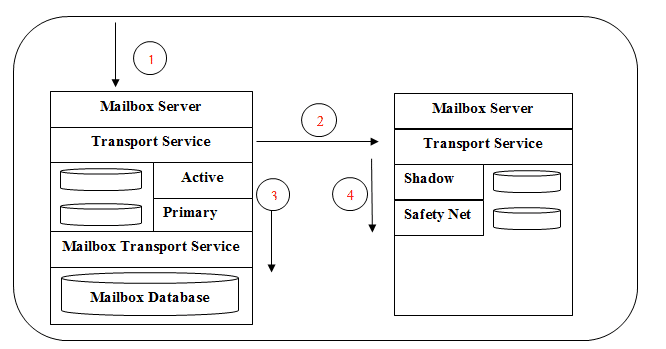Within Exchange 2013, the only major roles available are the Mailbox Server and Client Access Server roles. These roles contain the features required to allow mail flow to be delivered in and out of the organization.
The Mailbox Server role has built-in safeguard mechanisms which are used to protect the integrity of email deli
Within Exchange 2013, the only major roles available are the Mailbox Server and Client Access Server roles. These roles contain the features required to allow mail flow to be delivered in and out of the organization.
The Mailbox Server role has built-in safeguard mechanisms which are used to protect the integrity of email delivery; these features are Shadow Redundancy and Safety Net (which was named Transport Dumpster on Exchange 2010). The Mailbox role holds these features for high availability and supplies the delivery and submission of messages from the mailbox database to the Transport Service and vice-versa.
The Client Access Server role is the only role that accepts SMTP connections and relays them to the Transport Service to determine delivery options. It is also the only role that does not contain redundancy. Below is a simple graph of the Exchange 2013 roles and a description of each role.
very; these features are Shadow Redundancy and Safety Net (which was named Transport Dumpster on Exchange 2010). The Mailbox role holds these features for high availability and supplies the delivery and submission of messages from the mailbox database to the Transport Service and vice-versa.
The Client Access Server role is the only role that accepts SMTP connections and relays them to the Transport Service to determine delivery options. It is also the only role that does not contain redundancy. Below is a simple graph of the Exchange 2013 roles and a description of each role.
Transport Role

– Accepts client connections.
– SMTP mail flow (HUB 2010)
– Mailbox communication between transport and DB.
– Delivers messages to mailbox database.
– Submission RPC messages from DB to transport service.
Here are some requirements for Shadow Redundancy:
– Must have multiple Mailbox Server roles.
– Must have a primary and slave server mailbox.
– Both servers must be in a DAG or part of a high availability boundary.
Here are some points worth mentioning for Safety Net:
– A DAG is not required for this environment.
– Safety Net function will only work after a primary server is not available for a period of 12 hours.
To better grasp the concept of the Shadow Redundancy and Safety Net, I have provided a graph and step by step process of the mail flow through the Mailbox Server role.
SCENARIO
DAG TRANSPORT BOUNDRY
1- Message is received in our redundant environment.
2- Transport service opens a session to the second server to make a shadow copy.
3- Message is delivered from Transport Service to the Mailbox Service role to the Mailbox database.
4- Once the secondary server syncs with the primary Safety Net, a copy of the message is sent from Shadow Queue to Safety Net which is then held for 2 days or more etc.




